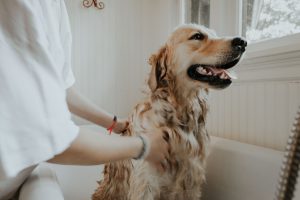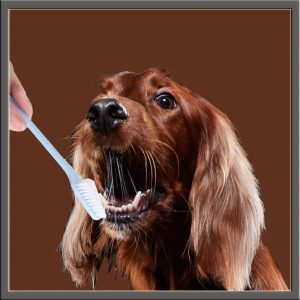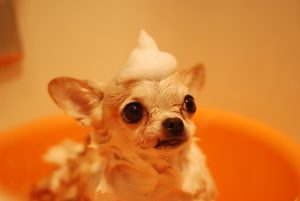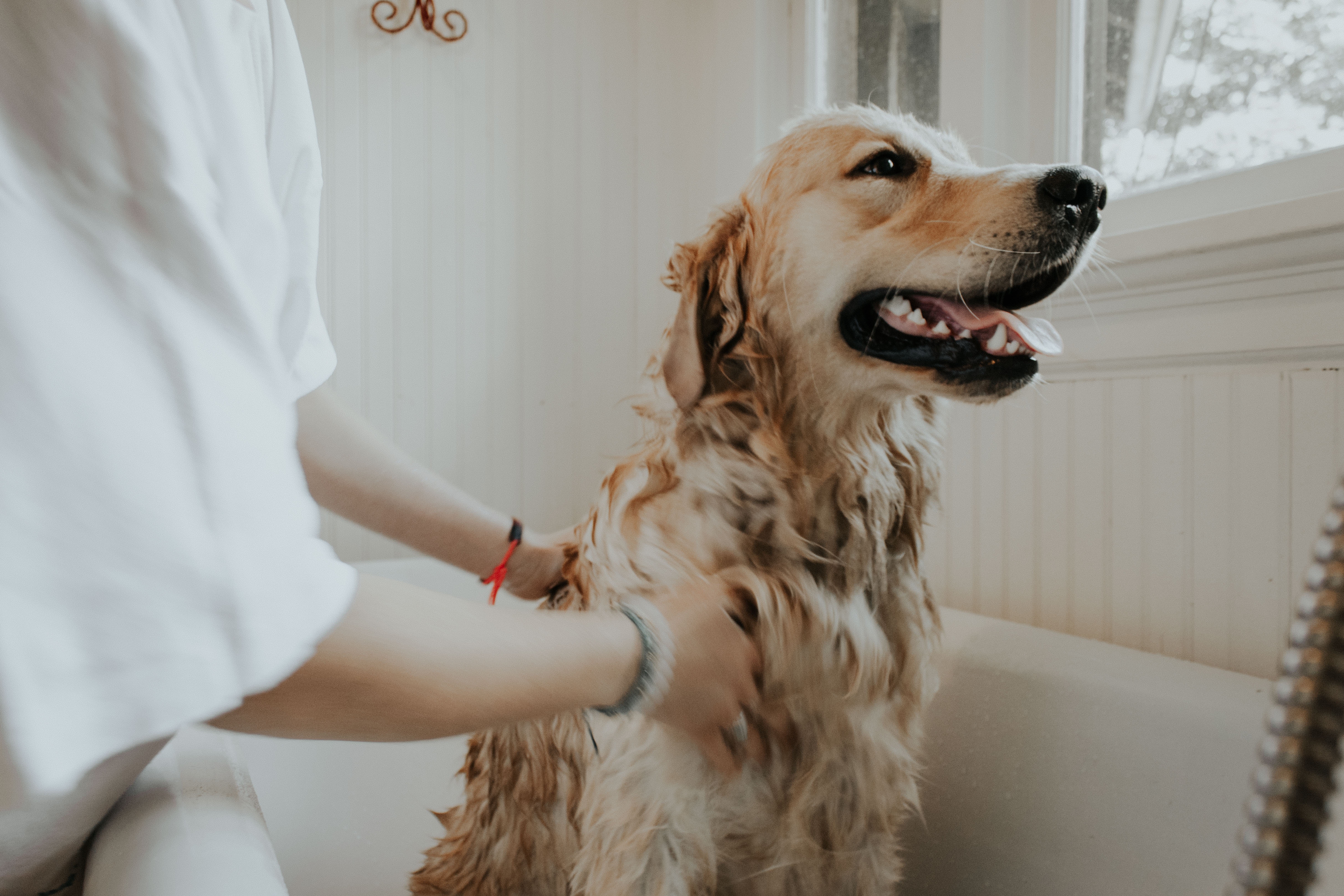
Save some money and DIY your spa day!
Grooming your dog at home can save you a lot of money, but where do you start and how do you groom your dog in a way that makes him comfortable and happy?
Sundays are what I call “spa day” for the littles. That’s when we take a bath, fill the bathtub with water, use lots of dog shampoo and breath freshener, buff my dog’s nails and get them clean and ready for the week. While spa day may come only once a week, there are some diy dog grooming tips that can come in handy in between your pup’s bath.

Brushing your dog’s teeth
Brushing your dog’s teeth is not only good for keeping his breath smelling fresh, but it’s good to maintain his gum health and the health of his teeth. Canine gum disease is a serious condition that is easily avoidable, but can be detrimental to your dog’s overall health. According to pets.webmd.com, while there are no outwardly signs of the disease progressing, it can devastate your dog’s mouth causing chronic pain, gums that erode, missing teeth and bone or tooth loss. We love our dogs and since this terrible disease can cause him extreme discomfort, we must take steps to prevent this.
Since plaque is the culprit that is the beginning of this condition, the first defense we have is brushing your dog’s teeth. My pups really don’t like brushing their teeth, let alone putting any kind of device into their mouths. Like anything else, learning to let you brush their teeth takes time and patience, and baby steps are a great way to start.
There are a variety of choices when it comes to toothbrushes, and my favorite is the rubber fingertip toothbrush that you can get from Amazon here.
Of course, he’s going to fight you and run under the kitchen table hoping to escape your newly presented rubber finger to stick in his mouth. What better way to entice him to join in the dental fun than with chicken flavored toothpaste. Yum! Slap some of that on your rubberized tooth brush and let him lick it. Mmmm, mmm! I don’t remember the last time my toothpaste tasted like chicken, but if you are a dog, that’s the stuff right there! Letting him lick your finger and get used to the new rubber toothbrush is a better way that what I did the first time, and that was to chase my Shaggy all over the house threatening him with bodily harm. Well, not really but it was a fight that I wasn’t going to win. Oh well. Live and learn.
As he gets used to the routine and allows you to introduce your rubber finger in his mouth, eventually it will become a part of his routine and that nasty bacteria that causes plaque and gum disease will be a battle you can and will win.

Cleaning your dog’s ears
Cleaning your dogs ears on a regular basis and making it become a regular part of his grooming routine is very importnat. Doing this each time you bathe him, or at least once a week will help to keep him healthy. One of the most important reasons to keep his ears cleaned is to prevent ear infections. The yeast that accumulate in his ears is a common cause of canine ear infections and keeping the ears free and clear of yeast can help keep infection at bay. If you have a dog with floppy ears, it presents a particular problem in that the ear flap keeps moisture inside and it becomes a breeding ground for bacteria. Nasty! It’s even more important to make the inspection and cleaning of his ears a priority in your daily/weekly routine.
How to clean your dog’s ears
If your dog is like my Shaggy, he doesn’t like cleaning his ears, In fact, my Shag has sensitive ears and winces each time I try to get in there and clean them out.
First of all, make him feel comfortable and relaxed while you set a grooming routine. Don’t chase him down and tackle him just to get at his ears. Use a calm tone and introduce your tools to him so he can get comfortable and familiar. Cotton balls and ear cleaner once a week will help clean out any dirt or excess wax. Simply apply the cleaner to the cotton ball, put the ball in his ear and massage the outside of the ear to move it around and wipe out the debris. Don’t use cotton swabs because they can push the wax further into his ear, and you don’t want to accidentally injure his ear drum. That would hurt and cause unnecessary harm.
If your dog has particularly dirty ears, be careful not to irritate the sensitive skin inside the ear by scrubbing that dirt out. Just do it a little at a time and repeat the process again in a few days. If you are looking for a great ear cleaning solution, try this one and click here

Giving your dog a bath – even if he hates it
The first thing I do before bathing my dogs is preparation. I get the bathtub ready, gather the towels and shampoo, put away anything on the floor that could get in the way of their bath, and I also clean their teeth and ears while in the tub so I get those things ready too. My pups don’t particularly care for cleaning their ears or teeth, so I do it while I have them captive in the bath. I bathe my two littles at the same time so they seem to behave when in the tub together.
When all of that is ready, I make sure I brush them thoroughly to remove any loose hair that might plug up my bathtub. Then in they go! Use lukewarm water and keep the environment calm and relaxed so as not to get them excited or agitated. A good dog shampoo that offers moisturizing properties is especially helpful if your dog has fine dander that can get matted when dirty. Be sure to rinse well and towel dry.
Often times I give the drying a head start with my blow dryer, and I turn it on in short bursts so as not to startle them in the process. Once I see that they are calm, I give them a good blowout and let them run off to get dirty again. A nice little treat is a great idea to reward them for good behavior, so that bathtime can become an occassion for them to look forward to. For an all natural, organic and hypoallergenic shampoo for your dog, click here
These are some simple things you can do to keep your dog clean and healthy in between your sessions with the groomer. Of course, all dogs and doggie mamas are different so use your own discretion as to how often you see the groomer depending on your breed and grooming needs.
We’d love to hear from you! Feel free to leave some comments below and visit our post titled: Why doesn’t my dog listen to me?

6 Comments
Hi,
Being an animal lover and having my own German Shepherd, I know what’s it’s like taking him to the Grooming Parlour and especially how expensive is it.
I really found your post interesting and is something I’m going to try from now on.
It’s very informative and goes into great detail, what your need to do to keep your dog happy.
Great website, keep up the good work 🙂
Steven
Thanks Steven! I love Spa Day with my Littles as it is time for us to bond. They have grown to love it and are so happy when they are done because it feels so good to be nice and clean! Have a great day and thank you for reading and commenting!
These are excellent tips! Thanks for sharing! At a recent visit to the animal clinic with our 7 year old dachshund the vet told us that we need to start brushing her teeth. Honestly, even having been around dogs my whole life, I’ve never brushed or seen anyone brush a dog’s teeth before! So this article will be very helpful for us.
Thank you for your comment Ryan! I too have been raised with dogs my whole life and never brushed their teeth. Knowing what I know now about dog’s overall health, I treat my dogs’ health as top priority as my own. Good job in taking the next step! Please come visit us again soon!
I bring treats with me into the tub to constantly reward my dog for good behavior. Another tip I’ve heard is putting peanut butter on the wall and letting them lick it while bathing them.
It’s always a great idea to reward our pups with treats for good behavior. Don’t we treat ourselves when we’ve been good? lol
And that peanut butter trick in the bathtub is genius! Keep em busy while you take care of business. Thanks for commenting Karol!